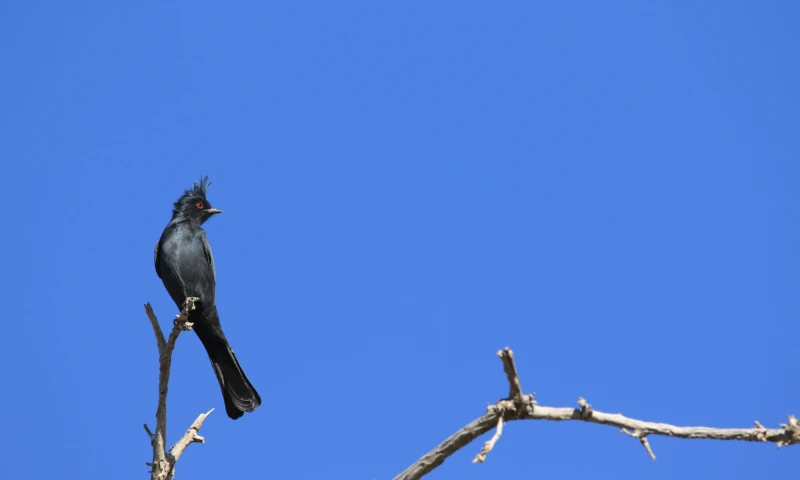By Morrigan DeVito
Photo by Alex Harper
Mar. 21, 2023. President Biden designated Avi Kwa Ame (also known as Spirit Mountain) in Southern Nevada as a new National Monument, a step in the right direction for bird conservation in the Mojave Desert at a time when water scarcity and rapidly warming temperatures are at an all time high. For especially vulnerable species like the Bendire’s and LeConte’s Thrashers, the designation provides a buffer against the effects of climate change, habitat loss, and drought.
Sacred to the Mojave, Chemehuevi, Southern Paiute, and other tribal nations, the 500,000 acres of Avi Kwa Ame National Monument are now protected from all future development. Within that circle of protection are Nevada’s old growth Joshua trees at the Wee Thump Joshua Tree Wilderness west of Searchlight, NV. Listed as an Important Bird Area by National Audubon, the Joshua trees are indicators of climate change because of their slower reproduction in response to hotter temperatures and drought. In the Southern Paiute language, “Wee Thump” means “ancient ones”, a fitting name for this wilderness where some Joshua trees stand 30 ft. tall and are over 900 years old. Interspersed with yucca, cholla, creosote, and white bursage, the scaly Joshua trees are critically important for many birds. Wintering Western Bluebirds, Northern Flickers, and even Nevada’s only recorded Gilded Flickers rely on the soft tree cavities for shelter.
For the region’s highly threatened Bendire’s Thrashers and LeConte’s Thrashers, Avi Kwa Ame’s designation ensures that their breeding habitats are protected for generations to come. Both thrashers are listed as Species of Conservation Concern according to the 2022 State of the Birds, meaning they have lost half of their total population in the last 50 years. But the 2011 State of the Birds report found that public lands in the West support more than half of the breeding distribution of aridland birds, showing that this designation has high potential for their continued conservation.
These thrashers are notoriously difficult to monitor because they forage on the ground and nest in different places within their habitat every year. But with Avi Kwa Ame’s designation, there may be more opportunities for biologists to collect data on these elusive birds. Although both thrashers can be found in the Wee Thump Joshua Tree Wilderness swishing their bills through the leaf litter and dirt to pick out insects, they utilize different habitats. Amber-eyed Bendire’s Thrashers are migratory, often returning to Southern NV in late March to breed in the Joshua tree woodlands where they nest in Joshua trees, teddy bear cholla, catclaw acacia, and Mojave Yucca. The plain, longer-billed LeConte’s Thrashers are year-round residents of NV and prefer to nest in low elevation Joshua tree woodlands with silver cholla, as well as sandy washes in saltbush and creosote-bursage shrublands.
The 2022 State of the Birds states that co-creating solutions with indigenous communities and advocating for public lands is essential to bird conservation, especially aridland birds like thrashers. The success of Avi Kwa Ame as an indigenous-led movement showcases the power of uplifting indigenous voices and activism. Now, Avi Kwa Ame will be co-stewarded with tribal nations to honor their sacred lands and spiritual traditions, meaning that tribes will have a say in how the monument is managed. Red Rock Audubon Society worked with the Avi Kwa Ame coalition, led by Nevada Conservation League, to advocate alongside indigenous nations for the protection of this unique habitat.
Originally petitioned to become a national monument by a broad coalition of tribal nations, environmental nonprofits, town residents, and outdoor recreation groups after solar energy companies threatened to develop it, Avi Kwa Ame National Monument now connects other public lands across the Mojave Desert. The Mojave National Preserve, Castle Mountains National Monument, Mojave Trails National Monument, and Lake Mead National Recreation Area are just some of the protected land that is no longer isolated.
With so many desert birds already pushed to the brink of tolerance because of increasing temperatures and the megadrought, the connective tissue of Avi Kwa Ame ensures that previously fragmented land can now sustain more of the Mojave Desert’s plants and animals. For example, sandy catclaw acacia washes throughout Avi Kwa Ame National Monument are vital to threatened Phainopeplas which rely on desert mistletoe crop gleaming from the branches of catclaw acacias.
The landscape of Avi Kwa Ame may seem very still and quiet, but swaths of creosote and white bursage attract Brewer’s Sparrows, Black-throated Sparrows, Verdins, and more. Golden Eagles and Red-tailed Hawks soar on thermals over a land stippled with smaller birds like Anna’s Hummingbirds, Ash-throated Flycatchers, and Cactus Wrens to name a few more. Other animals like bighorn sheep, black-tailed jackrabbits, desert tortoise, and mountain lions are also given more space to roam and breed, vital to keeping their populations genetically viable.
Although there is still much work to be done like monitoring LeConte’s and Bendire’s Thrashers, Avi Kwa Ame National Monument is a big step forward towards a more resilient future for birds living in the Mojave Desert. Will you visit the birds in Avi Kwa Ame National Monument and keep advocating for their conservation?










